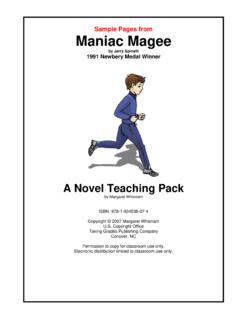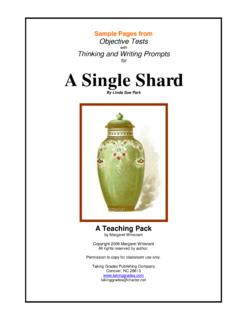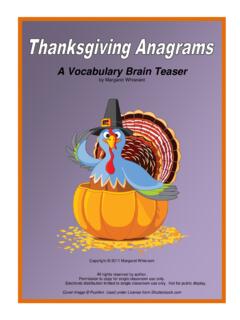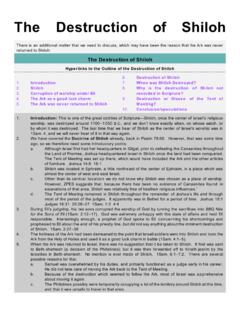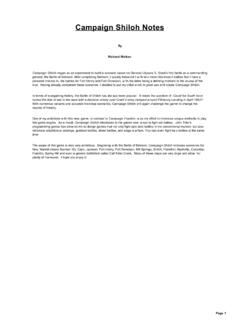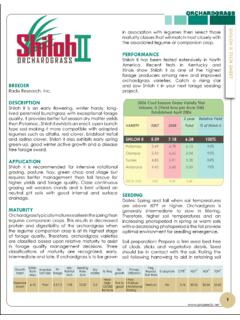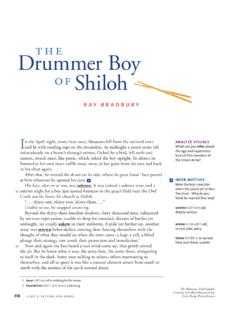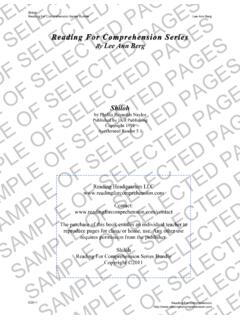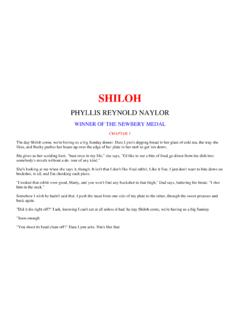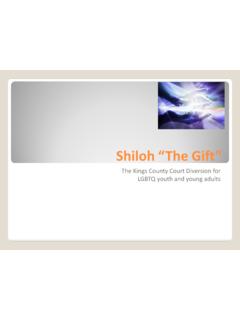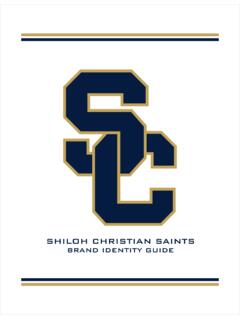Transcription of Sample Pages from Objective Tests Answer Keys for Shiloh
1 Sample Pages from Objective Tests and Answer Keys for Shiloh By Phyllis Reynolds Naylor 1992 Newbery Medal Winner A Teaching Pack By Margaret Whisnant Copyright 2008 Margaret Whisnant Permission to copy for classroom use only. All rights reserved by author. Taking Grades Publishing Company 1110 4th St. Dr., Conover, NC 28613 Table of Contents Objective Tests Chapter Tests Page Chapter 1 ..1-2 Chapter 2 .. 3-4 Chapter 3.. 5-6 Chapter 4.. 7-8 Chapter 5.. 9-10 Chapter 6 .. 11-12 Chapter 7 .. 13-14 Chapter 8 .. 15-16 Chapter 9 .. 17-18 Chapter 10.. 19-20 Chapter 11 .. 21-22 Chapter 12 .. 23-24 Chapter 13 .. 25-26 Chapter 14.. 27-28 Chapter 15 .. 29-30 Whole Book Test .. 31-32 Keys .. 33-34 About Your Teaching Pack .. 35-36 Copyright 2008 Margaret W hisnant Taking Grades Publishing Company Conover, NC 28613 1 Shiloh By Phyllis Reynolds Naylor Chapter 1 Pages 11-18 Write the letter of the correct Answer in the blank before each question.
2 _____1. What food did Marty refuse to eat? (A) wild greens, (B) fried rabbit, (C) peas. _____2. Marty lived in (A) West Virginia, (B) Virginia, (C) Kentucky. _____3. Even though he had a rifle, Marty never (A) took it on his walks, (B) wanted to shoot it, (C) shot at anything moving. _____4. The area where Marty lived was (A) wide valleys surrounded by mountains, (B) high up in the hills, (C) mostly rolling hills. _____5. Marty s favorite time of the day to go up in the hills was (A) night, (B) in the early afternoon, (C) early morning. _____6. When Marty went walking up in the hills, he (A) hunted rabbits, (B) watched animals, (C) set traps. _____7. Marty s favorite place to walk was (A) along the road that followed the river, (B) across the ridge of a mountain, (C) inside a small cavern he had found. _____8. When Marty first saw the dog, it was following him (A) with its tail wagging, (B) at a slow pace with its head up, (C) with its head down and its tail between its legs.
3 _____9. What kind of dog was Shiloh ? (A) an Irish setter, (B) a retriever, (C) a beagle. _____10. From the way the dog behaved, Marty figured it had been (A) abused, (B) trained for hunting, (C) lost for a long time. _____11. The dog came to Marty when he (A) whistled, (B) slapped his leg, (C) said Here, girl. _____12. Before Marty could get home (A) the sun had set, (B) the air had turned chilly, (C) it started to rain. Copyright 2008 Margaret W hisnant Taking Grades Publishing Company Conover, NC 28613 2 Shiloh By Phyllis Reynolds Naylor Chapter 2 Pages 19-27 Write either Yes or No in the blank before each question. _____1. Did Marty want to take his piece of rabbit out to Shiloh ? _____2. Did Ma tell Marty to go ahead and feed the dog? _____3. Did Marty feed Shiloh a raw egg? _____4. After supper, did Dad put Marty and Shiloh in the jeep and head out to Judd Travers place? _____5. When Marty said he wanted to be a traveling vet, did his dad encourage him to hold on to his dream?
4 _____6. Was it the month of July when Marty found Shiloh ? _____7. Was Judd Travers a well-liked man? _____8. Did Marty think Judd Travers probably took good care of Shiloh ? _____9. Did Marty like Judd Travers? _____10. Had Marty tried to help the store owner when he saw Judd cheat him? _____11. As the jeep made the turn at the boarded-up school, did Shiloh begin to tremble? _____12. Did Dad think Marty should report Judd to the authorities for mistreating Shiloh ? Copyright 2008 Margaret W hisnant Taking Grades Publishing Company Conover, NC 28613 3 Shiloh By Phyllis Reynolds Naylor Chapter 3 Pages 28-36 Write either True or False in the blank before each statement. _____1. All through the night, Marty either dreamed or thought about Shiloh . _____2. Marty felt he had disappointed Shiloh by making friends with him and then taking him back to Judd to be kicked. _____3. Marty was sure Judd would be willing to sell Shiloh to him. _____4. The living room couch was also Marty s bed.
5 _____5. Marty s dad worked at the post office. _____6. Even though he often took care of his two younger sisters, Marty never asked his parents for money. _____7. The quickest way Marty could earn the money he needed was picking up cans and bottles for recycling. _____8. No one in the family guessed that Marty was thinking about Shiloh . _____9. Marty agreed to help his dad deliver catalogs because he thought he might get paid. _____10. There weren t many catalogs to be delivered. _____11. Marty s dad knew everybody s name on his route. Copyright 2008 Margaret W hisnant Taking Grades Publishing Company Conover, NC 28613 4 Shiloh By Phyllis Reynolds Naylor WHOLE BOOK TEST Write the letter of the correct Answer in the blank before each question. _____1. Shiloh was (A) a German shepherd, (B) a small collie, (C) a beagle. _____2. When he first saw the dog, Marty was (A) hunting, (B) walking near the old Shiloh school, (C) going into town. _____3. Marty and his family lived in (A) West Virginia, (B) Virginia, (C) Tennessee.
6 _____4. From the way the dog behaved, Marty knew it had been (A) mistreated, (B) well trained, (C) abandoned. _____5. Marty had (A) one older sister, (B) a younger brother and a sister, (C) two younger sisters. _____6. Marty s dad worked for (A) Doc Murphy, (B) the post office, (C) Mr. Wallace at the general store. _____7. The area where Marty lived was (A) flat grassy meadows, (B) high, steep hills, (C) rolling hills. _____8. Shiloh came to Marty when he (A) slapped his leg, (B) whistled, (C) snapped his fingers. _____9. Marty named the dog Shiloh because (A) he first saw it near the old Shiloh school, (B) he looked like he had been in a war, (C) his mother liked the name. _____10. When Marty and his dad took Shiloh back the first time, Judd Travers (A) was glad to see the dog, (B) kicked the dog, (C) accused Marty of stealing the dog. _____11. Marty wasn t allowed to have a pet because (A) the family didn t have enough money to take care of one, (B) Marty s mother had allergies, (C) Marty s dad didn t like animals.
7 _____12. Marty and Shiloh s story took place in the (A) spring, (B) fall, (C) summer. _____13. Marty slept on (A) the living room floor, (B) a cot in the hall, (C) the couch. _____14. How old was Marty? (A) eleven, (B) twelve, (C) thirteen. Copyright 2008 Margaret W hisnant Taking Grades Publishing Company Conover, NC 28613 5 About Your Teaching Pack The primary goal in creating the teaching packs for children s novels is to provide a classroom-ready, non-threatening method for checking student comprehension and stretching thinking skills. When used as a basic guide for teaching a novel, the materials offer many and varied opportunities for learning. Use your teaching pack as a guide and lead your students into discovering new ideas about .. THE PLOT Each test page is actually an outline of the plot. In your teaching pack, the chain of related events that tell the story has been pulled from the novel and reformatted into a series of questions. Whether they are aware of their ability or not, all good readers sense the rhythm of the connected events that compose the plot; and consequently comprehend the story.
8 This plot rhythm is the basic structure of the Tests . To further your students understanding of plot, try the following activities: Summarizing the Story: Using only the chapter questions as a guide, have your students write a summary of the chapter. For a set of ten questions, limit the number of sentences they may write to seven. For twenty questions, allow no more than twelve sentences. Reporting the News: Have students write a newspaper article, based on the events from a set of questions, and add the who, what, when, where, why format. Some needed information may be located in previous chapters. Twisting the Plot: Choose one or two questions from each chapter and change its Answer true to false, no to yes, or a different Answer and explain how changing a single (or several) events would change the story. To further illustrate the rhythm of a good story, try changing the answers to one complete set of questions. Your students will see how difficult, if not impossible, it is to tell a sensible story from a tangled set of events.
9 THE CHARACTERS Questions that illustrate character motivation and personality are purposely included. Too often, when they are asked to tell what kind of person a story character is, the only Answer many of our students can muster is nice. In your efforts to remove nice from your students literary vocabulary, try this idea: Character Charts: Display individual charts for the main characters. As the chapters are read, record facts, behaviors, or events that relate to the each character. Then connect the items with several appropriate words such as empathetic, brave, calloused, bold, untrustworthy, etc. The teacher can take the lead by contributing the first few words and then assigning the task of identifying more terms to students. Record the word collections on the charts with the story facts. This information is a valuable student resource when displayed in the room for all to see and use during a writing assignment.
10 In creating and using character charts, students will soon begin writing more fluently and insightfully about story personalities. Use the charts to encourage your students to try some predicting or detective writing about what the character(s) might do next or what might have happened after the story ended. Let the charts help your students recognize CHARACTER CHANGE (dynamics). Another fun activity with the charts is to match a book personality with a zodiac sign. Students must justify their reason for thinking a character is a particular sign by citing his/her behaviors, words, reactions to situations, etc. that prove the match. READING BETWEEN THE LINES (Implied Meaning) Because the primary goal for the Objective questions is basic comprehension, items requiring a student to interpret an event or a character s behavior are not included. Always included, however, are questions that establish the existence of a story component carrying an implied meaning.

